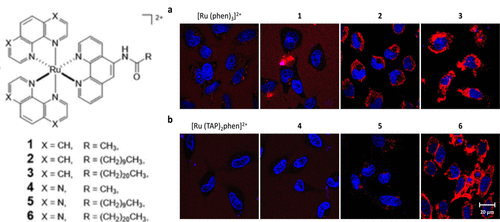当前位置:
X-MOL 学术
›
ACS Appl. Bio Mater.
›
论文详情
Our official English website, www.x-mol.net, welcomes your
feedback! (Note: you will need to create a separate account there.)
Effect of Alkyl Chain Length on the Photophysical, Photochemical, and Photobiological Properties of Ruthenium(II) Polypyridyl Complexes for Their Application as DNA-Targeting, Cellular-Imaging, and Light-Activated Therapeutic Agents
ACS Applied Bio Materials ( IF 4.6 ) Pub Date : 2021-08-19 , DOI: 10.1021/acsabm.1c00284 Sandra Estalayo-Adrián 1, 2 , Salvador Blasco 1 , Sandra A Bright 3 , Gavin J McManus 3 , Guillermo Orellana 4 , D Clive Williams 3 , John M Kelly 1 , Thorfinnur Gunnlaugsson 1, 2
ACS Applied Bio Materials ( IF 4.6 ) Pub Date : 2021-08-19 , DOI: 10.1021/acsabm.1c00284 Sandra Estalayo-Adrián 1, 2 , Salvador Blasco 1 , Sandra A Bright 3 , Gavin J McManus 3 , Guillermo Orellana 4 , D Clive Williams 3 , John M Kelly 1 , Thorfinnur Gunnlaugsson 1, 2
Affiliation

|
A family of six Ru(II) polypyridyl complexes (1–6) which contain phenanthroline-based ligands functionalized with alkyl chains of different lengths (one methyl group, 10 and 21 carbon alkyl chains) and either 1,10-phenanthroline (phen) or 1,4,5,8-tetraazaphenanthrene (TAP) as ancillary ligands have been synthesized and characterized. The influence of the alkyl chain length on their photophysical and photochemical properties as well as in their photobiological applications has been elucidated by monitoring the changes in their MLCT-centered absorption and emission bands. The presence of one methyl group or 10 carbon alkyl chains does not seem to significantly affect the photophysical and photochemical properties of the resulting Ru(II) complexes when compared to the well-known [Ru(phen)3]2+ and [Ru(TAP)2phen]2+. However, an effect on their emission properties and in their ability to photosensitize singlet oxygen is observed for the Ru(II) complexes containing 21 carbon alkyl chains. The binding of these complexes to salmon testes DNA (stDNA) was investigated by observing the changes in the photophysical properties. Complexes 1, 2, 4, and 5 all showed changes in their MLCT bands that could be analyzed using conventional fitting methods, such as the Bard equation. In contrast, complexes 3 and 6, possessing long aliphatic chains, gave rise to nonclassic behavior. In addition to these analyses, both thermal denaturation and circular dichroism studies of 1–6 were carried out in the presence of stDNA which confirmed that these complexes bind to DNA. Confocal microscopy and viability studies in HeLa cervical cancer cells reveal an alkyl chain-length dependence on the cellular uptake and cytotoxicity of the resulting Ru(II) complexes due to an enhancement of their lipophilicity with increasing alkyl chain length. Thus, complexes containing 10 and 21 carbon alkyl chains are rapidly taken up into HeLa cells and, in particular, those with 21 carbon alkyl chains show a significant phototoxicity against the same cell line. Therefore, this study provides further insight into the possible modulation of the photophysical, photochemical, and photobiological properties of Ru(II) polypyridyl complexes by varying the length of the alkyl chains attached to the polypyridyl ligands coordinated to the Ru(II) center and the nature of the auxiliary groups, which we show has a significant effect on photophysical and biological properties.
中文翻译:

烷基链长度对钌 (II) 多吡啶基配合物作为 DNA 靶向、细胞成像和光激活治疗剂的光物理、光化学和光生物学特性的影响
六种 Ru(II) 多吡啶基配合物 ( 1 – 6),其中包含用不同长度的烷基链(一个甲基、10 和 21 个碳烷基链)和 1,10-菲咯啉 (phen) 或 1,4,5,8-四氮杂菲 (TAP) 官能化的菲咯啉基配体辅助配体已被合成和表征。通过监测以 MLCT 为中心的吸收和发射带的变化,阐明了烷基链长度对其光物理和光化学性质以及它们的光生物学应用的影响。与众所周知的 [Ru(phen) 3 ] 2+和 [Ru(点击)2苯] 2+ . 然而,对于含有 21 个碳烷基链的 Ru(II) 配合物,观察到它们的发射特性和它们对单线态氧的光敏能力的影响。通过观察光物理性质的变化,研究了这些复合物与鲑鱼睾丸 DNA (stDNA) 的结合。配合物1、2、4和5都显示了它们的MLCT带的变化,这些变化可以使用传统的拟合方法(例如 Bard 方程)进行分析。相反,具有长脂肪链的配合物3和6会产生非经典行为。除了这些分析,热变性和圆二色性研究1 - 6是在 stDNA 存在下进行的,这证实了这些复合物与 DNA 结合。HeLa 宫颈癌细胞中的共聚焦显微镜和活力研究揭示了烷基链长度依赖于所产生的 Ru(II) 配合物的细胞摄取和细胞毒性,因为它们的亲脂性随着烷基链长度的增加而增强。因此,含有 10 和 21 个碳烷基链的复合物被迅速吸收到 HeLa 细胞中,特别是含有 21 个碳烷基链的复合物对同一细胞系显示出显着的光毒性。因此,本研究进一步深入了解光物理、光化学、
更新日期:2021-09-20
中文翻译:

烷基链长度对钌 (II) 多吡啶基配合物作为 DNA 靶向、细胞成像和光激活治疗剂的光物理、光化学和光生物学特性的影响
六种 Ru(II) 多吡啶基配合物 ( 1 – 6),其中包含用不同长度的烷基链(一个甲基、10 和 21 个碳烷基链)和 1,10-菲咯啉 (phen) 或 1,4,5,8-四氮杂菲 (TAP) 官能化的菲咯啉基配体辅助配体已被合成和表征。通过监测以 MLCT 为中心的吸收和发射带的变化,阐明了烷基链长度对其光物理和光化学性质以及它们的光生物学应用的影响。与众所周知的 [Ru(phen) 3 ] 2+和 [Ru(点击)2苯] 2+ . 然而,对于含有 21 个碳烷基链的 Ru(II) 配合物,观察到它们的发射特性和它们对单线态氧的光敏能力的影响。通过观察光物理性质的变化,研究了这些复合物与鲑鱼睾丸 DNA (stDNA) 的结合。配合物1、2、4和5都显示了它们的MLCT带的变化,这些变化可以使用传统的拟合方法(例如 Bard 方程)进行分析。相反,具有长脂肪链的配合物3和6会产生非经典行为。除了这些分析,热变性和圆二色性研究1 - 6是在 stDNA 存在下进行的,这证实了这些复合物与 DNA 结合。HeLa 宫颈癌细胞中的共聚焦显微镜和活力研究揭示了烷基链长度依赖于所产生的 Ru(II) 配合物的细胞摄取和细胞毒性,因为它们的亲脂性随着烷基链长度的增加而增强。因此,含有 10 和 21 个碳烷基链的复合物被迅速吸收到 HeLa 细胞中,特别是含有 21 个碳烷基链的复合物对同一细胞系显示出显着的光毒性。因此,本研究进一步深入了解光物理、光化学、











































 京公网安备 11010802027423号
京公网安备 11010802027423号